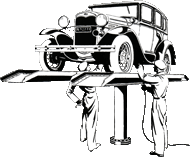
Model A
Ford Garage
Fuel Tank Filter Set-up


Timothy Kelly recently posted this great idea on fordbarn.com about how he sets up a Model A fuel tank filter to assist in cleaning out a dirty tank without removing the tank. Thanks for his permission to post it here, too!
Here are Timothy's instructions for tank cleaning in his own words:
The accompanying photo depicts how I solve my dirty Model A Ford fuel tank issues.
The inside diameter of these commonly available pipe fittings is significantly larger than the stock Model A fuel shut off valve. The larger inside diameter allows any and all dirt / rust that will cause a problem to enter the pipe and fall directly into the "dirty leg." The relatively clean gas is delivered to the factory sediment bowl for final filtering of any remaining fine bits of dirt and rust.
Early in the process I found the need to empty or drain the "dirty leg" every 100 or so miles. The frequency of cleaning will, obviously, depend upon the condition of each gas tank. In my experience, the gas tanks have rid themselves of dirt and rust in less than 1,000 miles. At this point, the "dirty leg" set up can be removed and replaced with the original hardware.
In my humble opinion, this process is far superior to adding additional filters as they tend to either a) prevent the dirt from entering the filter, as the particles may be to large to do so, which then in turn causes the dirt to remain in the tank, or b) become clogged rather frequently and require frequent replacement until the dirt is gone.
In the "dirty leg" set up there's nothing to replace. All that is needed to clean and drain the "dirty leg" is a small wrench, a short piece of welding rod (to unplug the leg as the sediment often packs in so tight that it won't release without a little help) and a coffee can to catch the dirt and gas once the valve has been opened and the clog disturbed.
I posted this picture once before, a few years or so ago, with a similar explanation, and several individuals expressed their concern about using copper pipe in a fuel system.
Yes, I understand the concern raised by constant flex of copper.....it cracks or breaks.
What I also understand is that Rolls Royce automobiles from the late 1920's (and maybe earlier and later) had copper fuel lines which ran from the back of the car, where the fuel tank was located, to the vacuum tank on the firewall. The length of this piece of copper is 18 feet more or less. And when one releases the clutch on an old Rolls to take off from a dead stop, the torque is such that the frame twists a bit before the car begins to move. Once in motion the frame begins to relax. And, I know of several old Rolls Royce autos which to this day are still using the original copper fuel lines notwithstanding the flex action.
I suspect that the copper pipe in my "dirty leg" set up which is less than two feet, suffers virtually no flex. Further, even if it were flexing a tiny bit, the set up can be removed in less than a 1,000 miles.....which is well before the copper pipe would break from any flex action.
If you happen to like the idea, and no one that I know who has used it has ever had a problem with it, go for it. If, however, you think the design is faulty, or otherwise causes you concern, then please skip it and settle on something more to your liking.
Good luck with whatever solution you employ!
Timothy KellyDecember 2008
Update:
Another advantage of the "dirty leg contraption" that I designed for one of my cars about ten years ago, which I did not but should have stated in my 2008 post, is that the inside diameter of the plumbing fittings depicted in the photo I posted at that time is significantly larger than the inside diameter of the original fuel valve. This allows most any piece of debris that might be in the fuel tank from whatever source to be expelled from the tank through the dirty leg.
Also, it is important to empty the dirty leg before the debris fills the leg. Otherwise, you will have defeated the purpose of the dirty leg as debris will once again flow to the carburetor.
Lastly, the same principal can be utilized for indented firewall tanks. It simply requires a few different fittings and assembly.
To date, I am not aware of anyone who has encountered a problem with using a dirty leg and have had a number of individuals send me notes expressing how well it worked for them.
As with fuel mileage, your experience may vary.
Timothy Kelly
August 2015
More Fuel Tank web pages on Ford Garage:
- For more Model A & B related information, use the Site Search box at the top or bottom of this page.
- Model A Cowl Tank Construction
- Model A Cowl Tank Filler Screen
- Russian ГАЗ-67B Gas Tank & Instrument Panel Details


